About the exhibition
Parallel to the large collections of a public or private nature, artists safeguard artworks for various reasons. Each collection reflects and bears witness to the life and related relationships among them. It is a selection of preferences and tastes that describe different moments in each artist's life. Exchanges, gifts, acquisitions, and chance encounters can be read in these dialogues. Thus, we present the first edition of "Artist Collections" in 2001, followed by the second in 2006. Now, in 2023, we inaugurate the third edition.
It is the artist Luis F. Benedit who describes the differences between various forms of collecting. He argues that "a collection is organized with a point of view from a perspective. (...) For the collector, the origin of the work, documentation, reproduction, the entire history of the work is very important. This requirement is very understandable because a collection must be documented. This attitude has nothing to do with the works that we, as artists, possess."
This proposal brings together eight artists with an exhibited heritage of around 400 works that bear witness to new and varied artistic practices. While in the past, they worked in their studios in isolation, nowadays, and for several years, grants, residencies, and workshops have driven collective creation and coexistence for extended periods, generating bonds that transcend in the case of these selected pieces.
The collections presented here share the artists' perspective through the chosen works, also recording a moment, an affinity of time. It is the sum of this series of exhibitions that allows for a historiography of Argentine art and its new practices.
Borrowing the works that artists keep in their homes and studios to present them in museum halls becomes a provocative gesture, a sort of foray into the intimacy of each creator, enriching not only our perception of their work but also of their private worlds.
Therefore, our deep gratitude goes to all the artists.
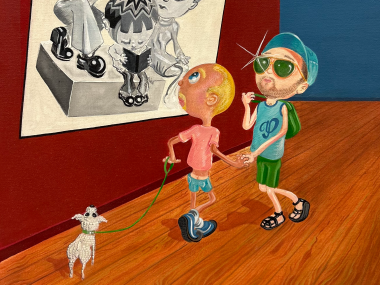 Alberto Passolini. Dink (Duble income, no kids)_, 2007
Alberto Passolini. Dink (Duble income, no kids)_, 2007
 Carlos Cima. Sin título (2019)
Carlos Cima. Sin título (2019)
 Cynthia Cohen. Sin título (2022)
Cynthia Cohen. Sin título (2022)
Cynthia Cohen Collection
The artist gives special value to the connection she establishes with different pieces. Since her childhood, she lived with works of art, especially those displayed in her grandfather's house, and through family connections, she frequented a cultural environment of artists and collectors that she considers the starting point of her education. Most of the works she owns come from gifts and exchanges with friends and colleagues; others were acquired on occasions where opportunities arose, and she could access productions that stirred admiration. These are pieces with which she lives, stating, "I respect the idea of establishing a commitment with them, having the works that we truly like and integrating them into the environment in an emotional connection." The collection did not form with a collectible spirit but rather happened organically, so it is perceived more as a custodian than as a collector. This emotional connection with the works is evident in the vase with flowers, an oil painting she inherited from her grandfather, the artist Juan Carlos Faggioli. It is also reflected in the photographs of her daughters, Sofía and Natalia Malamute, and in some others that show certain affinities with her own work. An appreciation for the paintings on the central wall and some objects highlights the vibrant palette's colors and, in a way, the playfulness, joy, and freshness of the artistic gesture. Regarding her relationship with painting, she says, "The work as a portal; the entrance to a personal universe, navigating through those waters naturally mine."
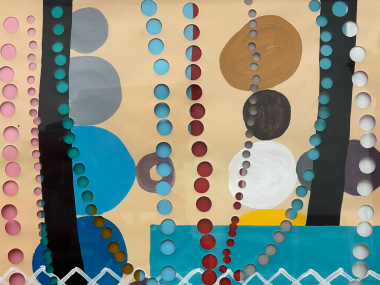 Valeria Maculan. Sin título, 2003
Valeria Maculan. Sin título, 2003
 Paola Vega. Sin título, 2019
Paola Vega. Sin título, 2019
 Daniel Joglar. Sin título, 2005
Daniel Joglar. Sin título, 2005
Inés Raiteri Collection
Since her childhood, Inés Raiteri had an interest in collecting objects. She inherited buttons, threads, and items from the haberdashery her family owned in her hometown, Mar del Plata. She acknowledges that from a young age, she began gathering multiple and diverse elements. In 1998, after moving to Buenos Aires, she started exchanging works with artists who participated in the Antorchas Fellowship, a radical experience in her life due to the proximity and dialogue established in artistic coexistence.
The character of her collection establishes a chromatic correspondence with the palette she uses in her productions, a distinction that sets her apart. Her first formal acquisition was a textile that attracted her because it seemed to play with something she had not yet discovered, a way of expressing through the artwork. Much of her collection is composed of artists who participated in the fourth edition of the Kuitca Fellowship (2003-2005), pieces she obtained mainly through friendly exchanges. She mentions that navigating together through that experience, where the intimacy of the creative process was carefully shared, had a different significance for her. She places special value on those productions she observed in their gestation.
Together with several female artists, she founded a collective that travels throughout the country and abroad, and many of the members are now part of her collection. "I think its most significant aspect is that it comes from my peers, with whom I shared many moments of my life and who were fundamental in the construction of my work."
 Flavia Tarnofsky. Sin título (1992)
Flavia Tarnofsky. Sin título (1992)
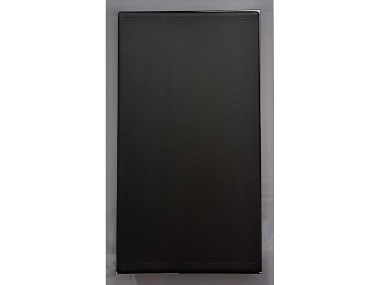 Ariel Mora. Sin título.
Ariel Mora. Sin título.
Cecilia Szalkowicz y Gastón Pérsico Collection
In the house they share, there are few artworks hanging, and a large number are in storage. They have been living there for a long time, and sometimes they rotate them, moving the pieces like other things, building a dialogue between them and the environment. They like to be accompanied by certain pieces for periods. They enjoy having and savoring them in stages: "It's our place, our habitat. If there were too many together, it would resemble the situation when many people speak at the same time. We prefer to have few, establish a temporary conversation with the pieces, a small quantity, more intimate, and find the pleasure of the effect they impose on the spaces." They know that at some point, they will be replaced.
They never stopped to think about their collection, and they never saw everything together. They call it that because it's the word that comes up; they treasure and care for their pieces, but the collection was not formed as such, neither consciously nor programmatically.
The majority are gifts, exchanges, or swaps in some collaboration situations or as a gesture of gratitude. It is primarily an emotional collection of friends and acquaintances with whom they have had or still have contact, good relations, and good dealings, stemming from close connections. It is a selection made by their emotional networks and is the way the pieces came to them. They reflect that it seems to have been constructed through a process opposite to what collectors typically do. "Like a portrait of us made by many people." There is no favorite; each has its own story. A few of them were purchased in friendly contexts, raffles, and auctions that they describe as games between them.
It resulted in a generational snapshot, artists who have been producing in the last two decades, perhaps some from earlier periods, aligning with their trajectories.
Gachi Hasper Collection
In her collection, a visually vibrant ensemble is evident, reflecting the fullness of color, in correspondence with the artist's production. The collection is extensive, encompassing works from different periods. While initially, her pieces came through reciprocal exchanges, she acquired others in settings like galleries and auctions, and these modalities continue to the present day. She acquires works that have sparked her impulse and interest or seeks special pieces that mark the historical precedents of women artists who explored various aspects of geometry in our country, antecedents to her own production.
It is an eclectic collection in styles, techniques, and materials that grew without special planning. She organizes her collection into four branches: abstractions, languages, the human figure, and landscape. This miscellany and its stories intersect with her career and the relational networks she has formed in her roles as an artist, teacher, and, in some cases, curator.
She is aware of her collector's spirit and enjoys the divergences established among her pieces; different generations and different eras. They are part of her biography, referring to friendly encounters, shared work, loving equities, and influences. In hindsight, she considers that her collection, along with those of her peers, represents the effervescent activity that characterizes our artistic scene.
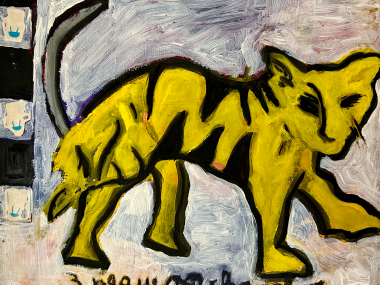 Diana Aisenberg. 3 pequeños chanchos, 1995
Diana Aisenberg. 3 pequeños chanchos, 1995
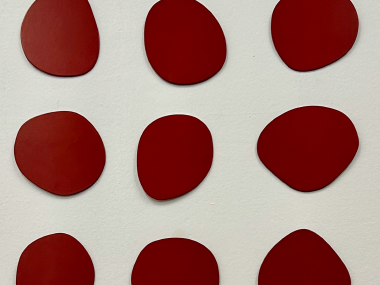 Irene Banchero. Sin título, 2002
Irene Banchero. Sin título, 2002
Marina De Caro Collection
The diversity of connections and experiences underlying the works in her collection revives personal stories that expose unexpected links and profound reflections, placing the pieces as living testimonies: "I like to think that works are subjects and not objects, and that in some way, they choose us," reflects the artist.
The collection is sustained by the inheritance of various pieces, including the work of Antonio Berni, which came through her mother. This contribution turns her collection into a visual legacy that transcends generations, emphasizing the importance of safeguarding and sharing the visual narratives that endure over time. A work by her son, Mishka, is also featured in the ensemble.
As a counterpoint, it is interesting to highlight the value of anonymous pieces, such as a small precious landscape and the embroidery located to the left of her wall - acquired at the Salvation Army - giving value to discarded elements. This act gives new life and meaning to the forgotten, while the artist grants aesthetic equivalence to these pieces.
The Kuitca Grant, like the case of other artists who exhibit their collections today, was a fruitful moment of exchange among its participants. Likewise, celebrating with friends is a privileged opportunity for gifting and exchange; for years, she has received works as birthday gifts, as evidenced by the dedications found on the backs of the works. However, not all pieces respond to an emotional relationship; she acquired some on different occasions, even from artists she did not know.
In many cases, the acquisition resulted from strong support among artists, a support network for friends during times when they sell or auction for various reasons. This is the case with the artist Benito Laren, central on this wall, who put up for sale a series of pieces to finalize the purchase of his house.
Many defy ownership conventions and circulated freely, "there's a poster by Romero that they handed out at some exhibition, and today, reviewing the works for this project, I realize that it's numbered and signed."
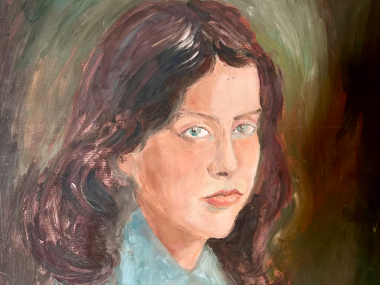 Horacio Schoijett. Retrato de Rosana Schoijett. Sin fecha
Horacio Schoijett. Retrato de Rosana Schoijett. Sin fecha
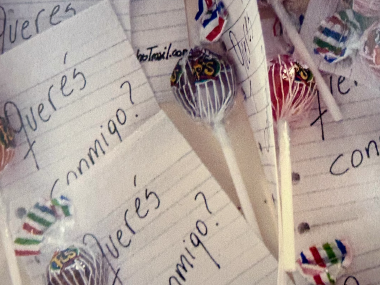 Colectivo Suscripci�n. Colecci�n Rosana Schoijett
Colectivo Suscripci�n. Colecci�n Rosana Schoijett
Rosana Schoijett Collection
The artist perceives the compilation of works she has built over time as a record of reciprocity and equivalences. "Every piece I have from an artist is because they also have one of mine, either a work or a record I made of their productions."
Her work as a photographic chronicler demonstrates a transversality with her own production and is also evident in the extensive collection she possesses, abundant in images and portraits.
She feels like a collector more than a collector, given how her collection was gradually built, adding pieces successively. She reflects that in the act of taking photos, there is already a similar attitude, a parallelism, "as if stealing snapshots from something that flows and does not stop, we collect those suspended, frozen moments that we manage to extract from that never-ending flow, life."
In the review of her works, the artist looked at them again and took a reverse path: "each of them is like a suspended snapshot of things that have happened, they bring to mind different moments and people, evoke experiences, there is a resonance with pairs of great enrichment, and giving each other works also has something like stopping, preserving something from that moment that is going to pass." She mentions that at the end of a scholarship or residency, exchanges accelerate, always with a nostalgic character; when groups are about to separate, that need to preserve something of that shared intensity appears. "Like trucks that flash their lights when they pass each other on the road, those signs of complicity."
She is interested in having a portrait of herself painted by her father displayed and also having two pieces that belong to her son's collection. The circular aspect that occurs in the collection.
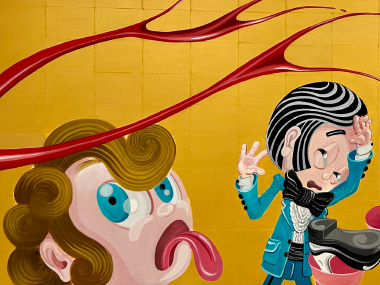 Alberto Passolini. Carrie y sus misoginos, 2007
Alberto Passolini. Carrie y sus misoginos, 2007
 Laura Ojeda Bär. Will happines find me, 2013
Laura Ojeda Bär. Will happines find me, 2013
 Alexandre Loye Aka Galou. Intérieur, 1993
Alexandre Loye Aka Galou. Intérieur, 1993
Sigismond de Vajay Collection
Sigismond de Vajay's collection is a visual testimony of a rich trajectory in connections, projects, exhibitions, and grants. Guided by pleasure and intuition, the configuration of his collection brought together a series of pieces in a selfless manner, in accordance with the artist's expressions. The collection offers a perspective that focuses on detail, textures, and perspectives. With an interdisciplinary approach, the curation highlights the monochromatic wall with a strong predominance of abstraction, which, along with Vajay's works, naturally engages in a dialogue, revealing his viewpoints.
In the segment that incorporates the human figure, Spencer Tunick's photograph stands out - positioned in the center of the wall - which received recognition for his work as a creator during the project carried out at Frida Kahlo's house, where 13 naked doubles were portrayed.
The circle expands with friendships reflected in the artworks and exchanges resulting from the various activities in which he participated. Some pieces were acquired in exhibitions where he served as a curator, producer, or manager, and his journeys trace a geographical and spatial route that shapes his artistic collection. Cities like Vevey, New York, Barcelona, Prague, and, finally, Buenos Aires, marked crucial stages in his development as an artist.
He always maintained a close connection with Swiss artists and engaged in various exchanges with them. Likewise, many of the exhibited artists came into contact with De Vajay at Fundación Proa during different exhibition projects in which he participated, such as Fabrice Gygi and Séverine Hubard - with whom he also shared a studio for years.
His commitment to the local art scene is evident through his work at Editorial KBB - which he founded - with an extensive series of editions of artists' books. A valuable contribution to the dissemination and promotion of their works. From these editions, exchanges also emerged that are part of the collection.